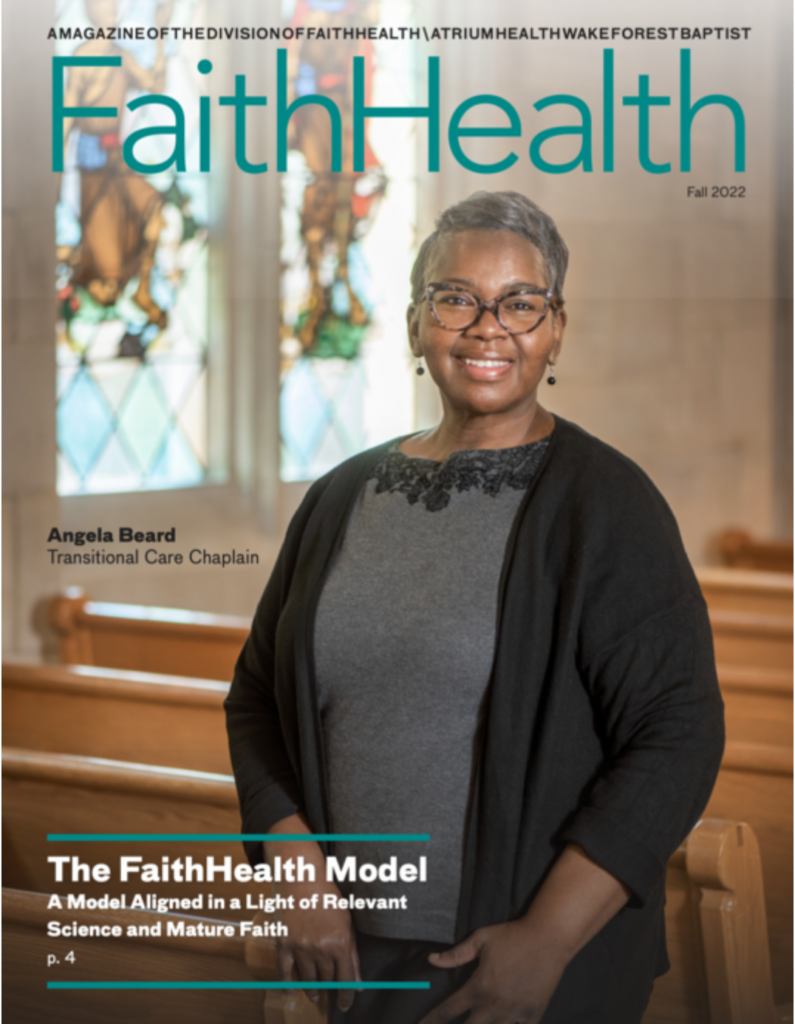By Teresa Cutts and Gary Gunderson
Before there were moms, dads, kids and neighbors, viruses such as COVID-19 have tried to kill us. Today, armed with astonishing technologies, we humans can detect and monitor viruses around the world in nearly real time. We once stood and watched on a bank of screens at the Centers for Disease Control in Atlanta as concerned epidemiologists zoomed into an African village, reporting a disease outbreak. But we really don’t know what viruses such as COVID-19 and any of its likely future mutations will do next in their relentless, constant and deadly innovation.
And that’s just viruses; there are many other categories of disease and pathology, not to mention the occasional weaknesses that come with being a hairless mammal walking around on two complicated feet and weak knees. The human journey may seem to be a story of death triumphant. But you’re probably not reading this article in a cave by firelight. Humans turn out to be quite competitive with all the things trying to kill us. Our ancestors would probably not mind giving up their caves for being trapped on a virus-infected cruise ship for a few weeks.
Viruses breed wildly and mindlessly, occasionally innovating in a deadly manner. Humans have only a few children, born out of something close to love. Yes, hairless and vulnerable, but wrapped by mom, dad, family, neighbors and now vast complex social structures of faith, government and voluntary organizations, all designed to give the next generation a chance to grow. Humans thrive and adapt not so much because we are cleverly hard-wired, but the opposite. Almost nothing is hard-wired in a human; we are wired to learn, change and adapt as a social species. And not just the mother-child dyad, but at every scale from family, neighborhood, congregation, voting precinct, city, state and national government, not to mention the ever-sprawling connective internet phenomenon. That’s how we live and find our way.
We live in times that many find toxic, depressing, traumatizing. Only recently have we come to grasp the long-term nature of the social bruising that many of us experience in early childhood.
Far from “getting over it,” these social wounds or Adverse Childhood Experiences (ACEs) affect us for decades resulting in mysterious patterns of disease and disability. These traumas damage the heart of our most powerful human capacities to nurture and care for each other, planting weakness exactly at our greatest strength.
Bryan Hatcher, our FaithHealth leader of CareNet, recently told the story of Tony, a neighbor who suffered under a poorly equipped single father who only knew the tool of violence and anger. Tony died early of diabetes after a lifetime struggle with alcohol and depression; of course, he did. Once you understand the whole complex life, it is easier to grasp that early death than it is to explain why so many other similarly wounded children do not follow the same trajectory. Early death is much easier to explain than the obvious fact that life goes on even amid traumatizing shocks. Life happens, not just death. Yet we have a far richer and ever-expanding vocabulary for our fears than our strengths. We know too much about death; what causes life?
What we have to work with
For those living apart from intense daily struggle of life against death, Leading Causes of Life is one more serving of happy talk. But for those finding their way on the bitter streets of racism and poverty, the language touches the thread that holds their lives together, explains why death does not win every time and why a dream of an assassinated preacher still lives a generation after his death. The Leading Causes of Life has now resonated across many other hard streets, including those that knew apartheid in South Africa, the toxic racism of Memphis and the deep South, the atrocities of Afghanistan and radical shocks of the mentally ill in India.
 Born out of obvious human suffering, the Leading Causes of Life point us toward the most important possible thing for anyone who loves anyone else—what we have to work with.
Born out of obvious human suffering, the Leading Causes of Life point us toward the most important possible thing for anyone who loves anyone else—what we have to work with.
The Leading Causes of Life are perhaps most relevant in the context of those traumas we inappropriately call “mental.” Every part of the medical system—from the buildings called hospital, to specialists to insurance companies—have taught us that the category of “mental” is different and apart from the biomedical wounds and diseases. The great gift of the recent research into ACEs has utterly abolished the distinction between biological, psychological, social and, yes, spiritual phenomena. And, when viewed through the lens of the Leading Causes of Life, the ACEs helps us see the constant generative and regenerative phenomena going on among us humans.
It happened that at the very moment we were thinking of the Leading Causes of Life in Memphis, we were being drawn into the mountains of Lesotho at the request of the World Health Organization. The governments of Africa were broken to their knees by what was understood as a viral disease called HIV/AIDS. The WHO asked if religious networks had anything to offer, so a small group of researchers organized by the Carter Center at Emory University and the University of Cape Town went to ground. Our first stop was in the high ground of Lesotho, where we quickly learned that the biomedical view of life poorly described anything, much less how HIV/AIDS worked (Lesotho had the highest incidence rates in the world). The villagers taught us that in their language it was impossible to distinguish faith from health, or health from faith. For that matter, it was impossible to distinguish people from their expansive social and ecological realities. Disease theory didn’t fit very well in Bophelo, but the Leading Causes of Life sure did.
Five Leading Causes of Life
The five leading causes of life do not recognize the sharp and unhelpful distinction between mental, physical and social wounds. Thus, it is highly relevant to preventing and managing the phenomenon called mental illness, as well as promoting and maintaining the things we call optimal mental health.
Connection has been documented since the early 20th century to be vital to human development and flourishing. Early on, babies in orphanages who were not routinely touched and cuddled were depressed, lethargic, did not thrive and often died prematurely. With advanced technology now, we see that being touched (particularly by a close loved one) when a person is going through testing like an MRI decreases anxiety and fear, regulates heart rate, relieves depression and lowers blood pressure. Social support enhances good mental health and well-being, no matter how much stress a person experiences, providing a buffer against stress. In World War II, children in London who were separated from their parents and families in order to keep them away from the German bombings, wound up being more stressed and had more subsequent mental health problems than children who stayed with their families, despite bombs falling nearby multiple times per day. In terms of the mental health of children experiencing ACEs, we know that any strong, stable relationships or connection (with a teacher, a neighbor, health provider or anyone who cares and understands the child’s triggers for acting out when exposed to toxic stress) can mitigate against the impacts of ACEs in later life.
Coherence, how people make sense of their lives and experiences, is pivotal to good mental health, particularly in terms of resiliency or  the ability to bounce back after problems. Even trauma victims as young as school-age children, in dealing with tragedies and deaths of family members after the 1989 San Francisco-Oakland earthquake, crafted their own narratives that changed to be more and more hopeful years after the quake. Similarly, Mothers Against Drunk Driving started after the tragedy of a traffic fatality, but telling that story gleaned goodness and a useful program from that tragedy. These stories aided in healing, not only individuals, but whole communities who lost loved ones to those driving under the influence. James Pennebaker’s research on self-disclosure (“getting things off your chest”) found that people who shared formerly hidden secrets showed decreases in anxiety, depression and improved immune system functioning—improvements that lasted long after stories/secrets were shared. In fact, post-traumatic growth syndrome (vs. the better known post-traumatic stress disorder or PTSD) is a phenomenon in which persons grow stronger after trauma and tragedy, as they craft their own story of healing (coherence), claim their sense of control (agency) and embrace the challenge of illness or problems as an opportunity for growth.
the ability to bounce back after problems. Even trauma victims as young as school-age children, in dealing with tragedies and deaths of family members after the 1989 San Francisco-Oakland earthquake, crafted their own narratives that changed to be more and more hopeful years after the quake. Similarly, Mothers Against Drunk Driving started after the tragedy of a traffic fatality, but telling that story gleaned goodness and a useful program from that tragedy. These stories aided in healing, not only individuals, but whole communities who lost loved ones to those driving under the influence. James Pennebaker’s research on self-disclosure (“getting things off your chest”) found that people who shared formerly hidden secrets showed decreases in anxiety, depression and improved immune system functioning—improvements that lasted long after stories/secrets were shared. In fact, post-traumatic growth syndrome (vs. the better known post-traumatic stress disorder or PTSD) is a phenomenon in which persons grow stronger after trauma and tragedy, as they craft their own story of healing (coherence), claim their sense of control (agency) and embrace the challenge of illness or problems as an opportunity for growth.
Agency, or the ability to do and act in your environment, is also critical to good mental health. Self-efficacy, or the belief that a person can make a difference in their circumstances, gives people a sense of control, a key component of resiliency. Doing something, even in limited circumstances, improves depression and anxiety levels. We know that many HIV/AIDS orphans, particularly those caring for younger siblings, in sub-Saharan Africa in the 1980s through 2000, often had few resources beyond agency that kept them going and anchored them to the future. Their refusal to be a victim was a part of their role as agents of change in their own lives. Likewise, prisoners of war who survive often could do little but tap out codes to their adjacent cellmates or reconstruct poems and scripture on scraps of toilet paper, but these shreds of agency helped them remain sane and alive.
Blessing, or intergenerativity, often feels like a “bi-directional dose of love” from generation to generation or simply, from person to person. The Leading Causes of Life help us understand and work with the most obvious and astonishing human reality: generations, the wave of our young. As adults, our work and hope are generational. The test of everything we do with our own lives is whether we make generative choices, not only on behalf of our blood relatives, but for our neighbors and all seven billion who share our tiny blue marble. The science of psycho-neuro-immunology shows how our immune system function can be impacted by every encounter with others; encounters that feel like blessings enhance both physical and mental health. In one study, interventions of visiting and caring for others in visits three times per week decreased loneliness and depression and improved immune system functioning in those who are lonely AND those who make the visits. So, altruism, or doing good, helps both the giver and the “givee.” That effect is so powerful that even watching films of those blessing or caring for others, such as Mother Teresa, can decrease anxiety and depression and enhance immune system functioning.
Hope is a positive move toward the future, not just optimism, and plays a crucial role in good mental health. Study after study shows better cancer, cardiac and surgical treatment outcomes and improved anxiety and depression levels in those persons with higher hope levels. Something as simple as labeling a chemotherapy drug with an acronym called “H.O.P.E.” vs. “E.P.O.H.” improved cancer outcomes significantly. As Jevne puts it,
“Hope is an anecdote to fear [anxiety] … runs through all dimensions of life and is a shared experience, often grounded in community.” Jonas Salk, who figured out how to isolate and defeat the polio virus, found this soft-wiring to be the key to human hope; we could survive because we could be wise. We are not just built to resist death and disease; we are capable of emergent, adaptive life. Maybe even love and joy.
All the Leading Causes of Life make up an ensemble that can be accessed to contribute to both preventing mental health issues or coping with ongoing life stressors, anxiety, depression or other behavioral health concerns. Discern your own top Leading Causes of Life, that of your family, friends and/or congregations and communities and use them in your life journey today for improved mental health and increased resiliency.

